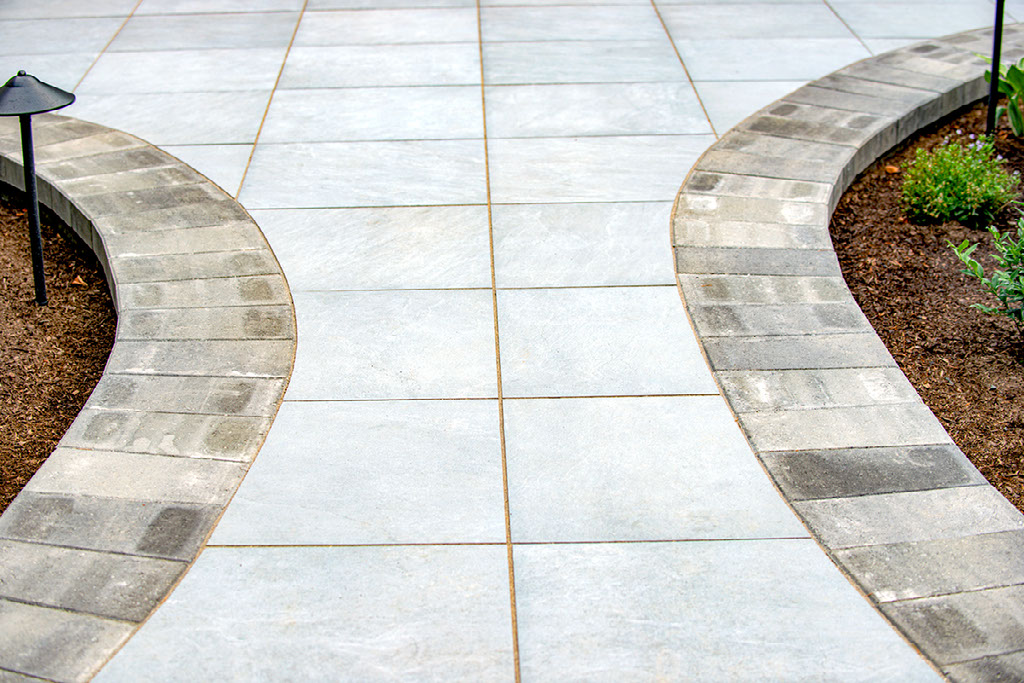Flagstone and bluestone are large, flat stones often used for patios, walkways, driveways, and pool decks. They are popular in landscape design due to their durability, natural stone look, rich colors, and versatility in installation, either setting them in sand or mortar sealer. Both are great options, but which you should choose will depend on your project and needs.
What is Flagstone?
Flagstone is a sedimentary rock, bound together by minerals and thousands of years of pressure. Sandstone, limestone, slate, and bluestone are common types of flagstones. Flagstone is a flat paving stone that can be cut and shaped in a variety of ways, allowing for unique patterns.
Known and loved for its rich texture, flagstone comes in a broad range of colors such as browns, grays, golds, and blues. If you enjoy a more rustic look then flagstone is best. The neutral-colored hues allow for integration into a natural landscape design for a more nature-centered look.
What is Bluestone?
Did you know that bluestone is a type of flagstone? This sedimentary rock is formed by the fusing of particles deposited by rivers, oceans, and lakes, and has a more moderately textured surface. The rich, blue-gray color is perfect for giving your hardscaping projects a look that will pop. Bluestone can also be incorporated for outdoor kitchen counter surfaces.
Maintenance
There is more maintenance needed for bluestone than other paver materials because it is porous, making it easier to stain. However, despite being porous, this rock is easy to clean. Food and dirt stains can be removed by scrubbing the surface with water and dish soap weekly or biweekly. Soap residue should be rinsed away when finished. Mixing a gallon of water with ammonia or using a traditional cleaner that does not contain bleach is recommended for tougher stains like grease or oil. The buildup of lime and mineral deposits is another form of staining that homeowners with bluestone products need to worry about. These develop a few years after installation but are easy to eliminate by mixing baking soda and vinegar to scrub down the bluestone tiles until the white spots are gone. To avoid too much cleaning, resealing every few years is suggested.
Shop Bluestone Architectural Porcelain Slabs

Which should you choose?
Given that bluestone is a type of flagstone, you can’t go wrong with either, it just depends on your project design and needs. Bluestone is sturdier and holds in place better than generic flagstone; it is more resilient against elements, making it weather resistant and perfect for outdoor living. It comes in natural cleft and select grades. Bluestone has a more classic and formal look, even among natural landscaping. Produce a clean, even aesthetic with cut bluestone pavers arranged in an ashlar or running bond pattern.
Flagstone preserves an earthy look and works well with contemporary hardscape designs. It grants optimal aesthetic flexibility, since it is available in an array of shapes, textures, and colors. A flagstone patio will not warp in the elements and is termite-proof, unlike wood decks. It also provides traction due to natural ridges and limits surface water pooling.
When left in their slightly rough, organic form, both are slip-proof, however, bluestone is naturally more slip-resistant. If you are working on a pool deck, patio design, or any other sun-prone area, remember that dark-colored bluestone retains more heat than lighter flagstone varieties. A bluestone patio or pool deck is best for durability, but it will be hotter to the touch in direct sunlight. When deciding which stone to use for your project, you will want to consider what it will be exposed to on a daily basis.

